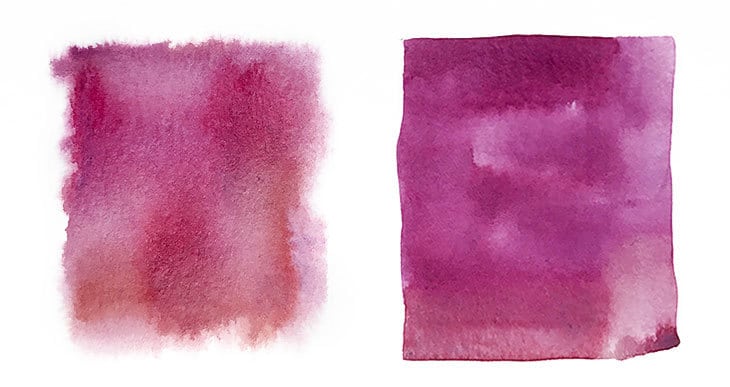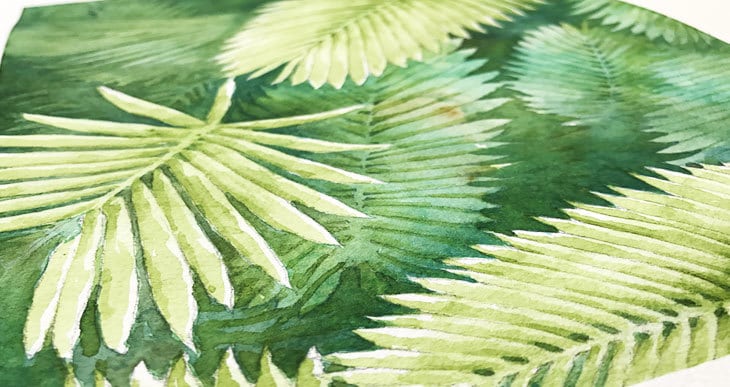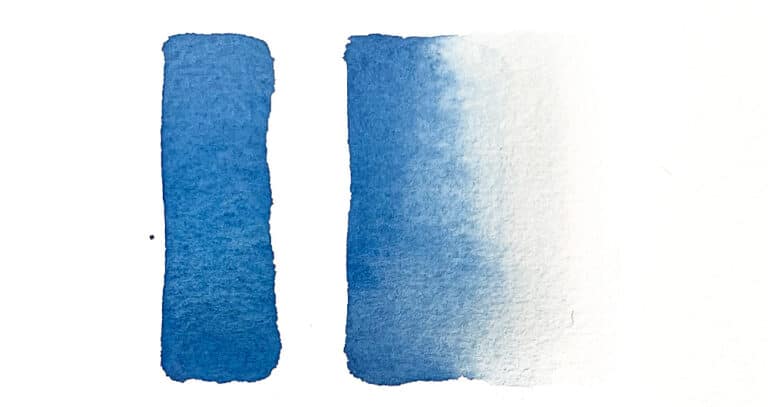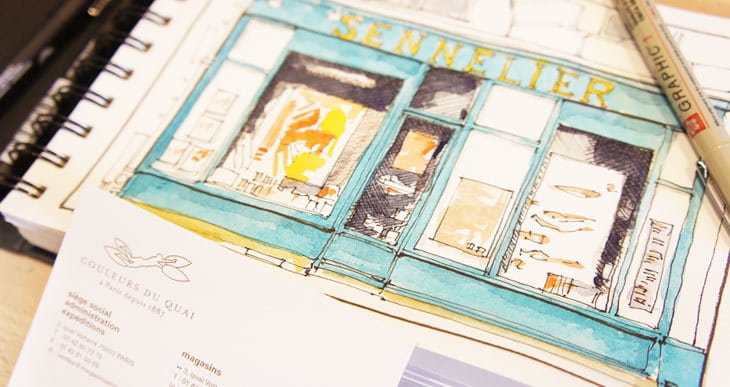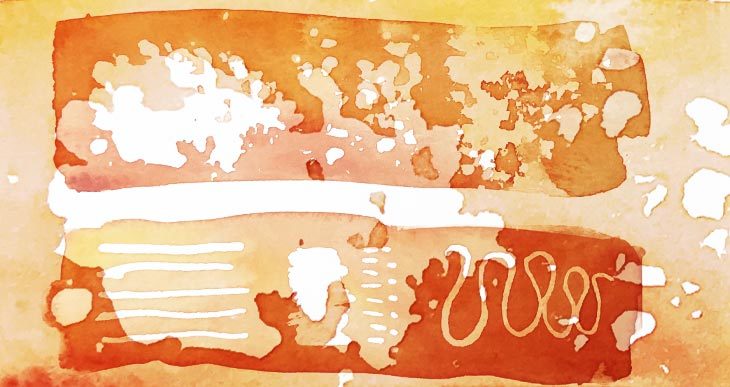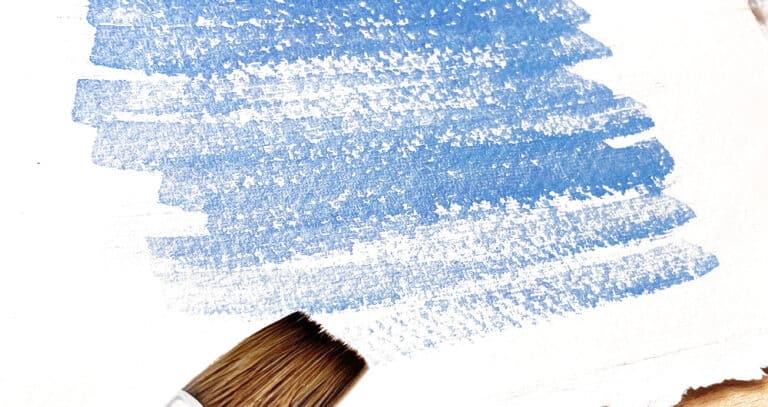Lifting Blotting and Erasing Watercolor Paint (Pro Tips!)
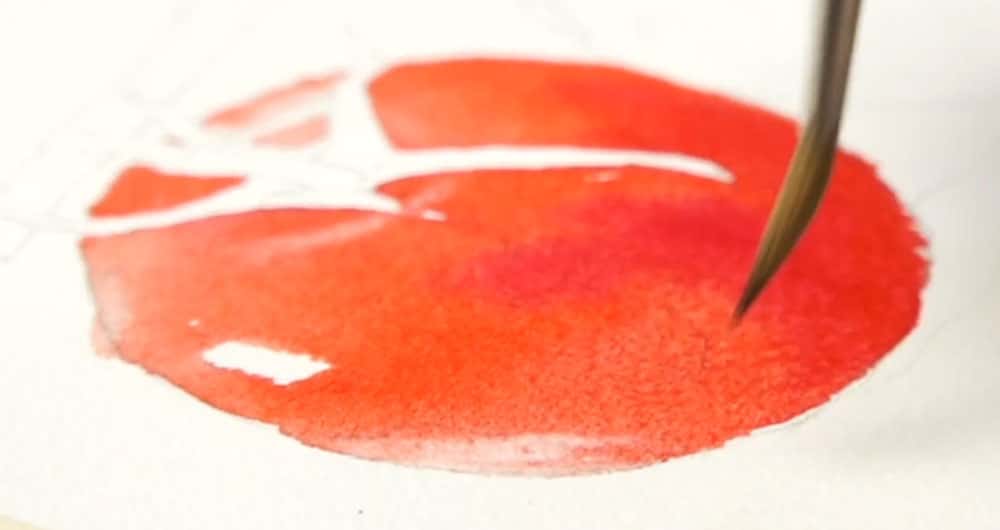
In watercolor painting, the lightness comes from the white paper reflecting back through the transparent paint.
But let’s face it… sometimes there’s just too much paint on the paper!
For example, you lay down a strong-colored watercolor wash but want certain areas to be lighter. Maybe you need to reveal highlights. And sometimes, there’s no practical way to paint around big light-toned shapes.
So what should you do?
Lifting, blotting, and erasing watercolor are essential to an artist’s “toolkit.”
These watercolor techniques help artists lighten the values in a painting or even remove the paint when necessary.
However, there are a few limitations and essential things to understand for these methods to work well.
What is The “Lifting Off” Watercolor Technique
Lifting is a technique for removing the color from the surface of watercolor paper. This is done to correct mistakes, lighten parts of a wash, create highlights, soften an edge, or lighten tonal values in a painting.
Watercolors aren’t like other paint mediums where you can add white to light a painting. Often you have to plan ahead and leave the lighter parts of the subject untouched. Like this, the white paper shows through, providing light-toned areas.
Lifting is part of the painting process with watercolors. You’re constantly adjusting the lightness and darkness of the painted shapes. A lifting technique allows you to control the amount of colored pigment on the sheet.
Also, watercolors are notoriously tricky to control. Sometimes the pigments wander off in a direction you didn’t intend.
Blotting or lifting corrects the occasional error 🙂
Note that lifting is not the same as masking. Masking methods are another way of preserving the paper, but the shapes are always pre-determined. And the results give hard edges. Most lifting techniques remove the color from the paper but leave a soft-edged appearance.
How to lift watercolor (lifting can be done wet, dry, or by re-wetting)
Watercolor artists use several methods and tools to lift or remove color. And lifting can be done at different stages of the painting process – during or afterward.
This technique can be executed in the following ways:
- While the paint is still wet
- By re-wetting the watercolors on the painting.
- When the surface is dry
Let’s have a look at each of these situations in turn…
Blotting watercolor – lifting while wet
You’ll see me do this often if you observe some of my painting demos. First, I lay down a colored shape, then blot up some of the pigments to lift out a highlight or brighten the values of part of the shape.
This watercolor blotting technique can be done with any absorbent tools. But the most practical is the brush you have in your hand!
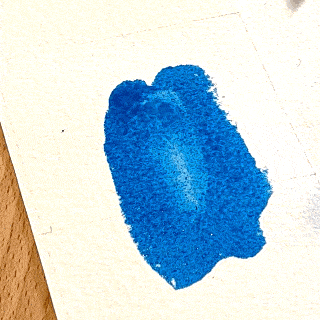
After painting a shape, I simply rinse and blot the brush on a soft cloth, then use the brush head to absorb wet paint from the surface of the paper. Rinse and repeat until you’ve removed enough color.
This is also another reason why I like natural-haired brushes. They are highly absorbent (they have a good “reservoir”) and are better for lifting.
Lifting by re-wetting
There are occasions when you decide to lighten the values of a painting after the paint has dried. This can be done by dampening the surface of the painting.
This works by reactivating the paint (similar to when you re-wet your dry pans of watercolor in a palette). You then use a brush to lightly scrub the painted surface. This gets the pigments loose.
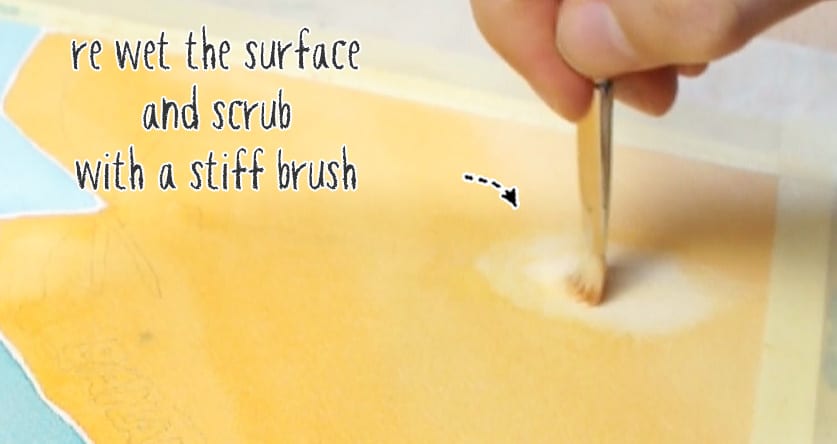
Sometimes I use a stiff bristle brush because it’s more abrasive and can help loosen the pigments.
You then use something absorbent, like a kitchen towel, to “lift off” the pigments.
Can you lift dried watercolor?
Dried watercolor paint is more difficult to lift. However, it can be removed using several different tools and methods. Most of these techniques use an abrasive tool to scrape or scrub the surface and literally erase the pigments from the dried painting.
I sometimes do this to scratch out paint and create highlights or bright details.
But this approach should be used with care. You can damage the paper surface easily. Abrasive techniques not only remove the paint but can also remove the paper sizing (all watercolor papers use sizing to control the absorbent properties of the sheet).
Too much scraping or rubbing can alter the handling properties of the paper, making it challenging to re-paint over the top.
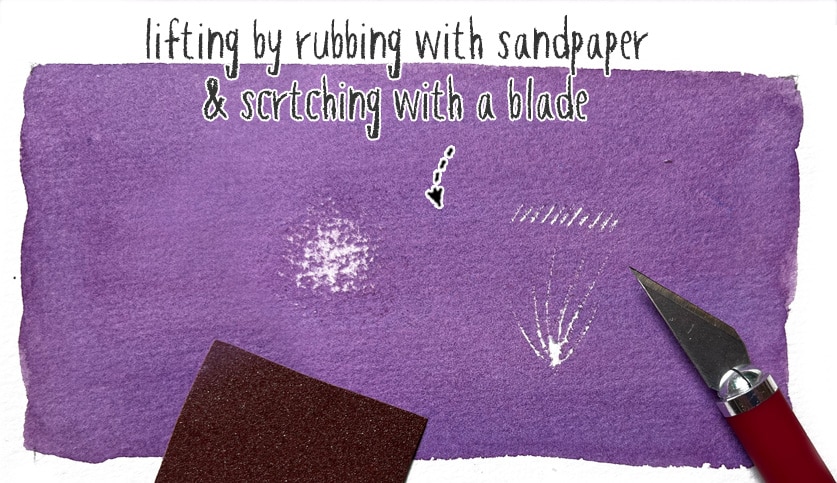
Did you know that The English landscape artist William Turner was the precursor of many of the lifting techniques we use today? He would scrape, wipe and scratch his paintings abundantly! See, for example, The Burning Houses of Parliament c.1835
Important things you need to know about lifting
The characteristics of your painting materials can also influence the effectiveness of watercolor lifting techniques. For example, certain types of paper or paint make removing the color from the surface easier (or more complicated).
Watercolor paper quality
The type and quality of paper you use affect the ability to lift paint from the surface.
This is because of two things:
- The way the paper is sized
- The texture of the paper
- The material that was used to make the paper.
For example, all watercolor paper uses sizing to control how wet paint is absorbed (sheets without sizing are like blotting paper and would soak up all the paint deep into the fibers). Poor quality sizing can lead to handling problems.
Some of the student-quality papers I use permit the colors to lift very easily. This is not necessarily a good thing! If every new brush stroke you make lifts off the previous brush marks, you end up with streaky results.
I prefer artist-quality papers like Arches. The sizing is well-balanced. The surface can be tougher to lift and remove paint, but this is a good thing. I try to control the highlights and values during the wet stage. And you can still lift pigments to a certain extent if needed.
The texture of the paper surface also affects its lifting properties to some extent. As a general rule of thumb, hot press (smooth) paper makes lifting easy. On the other hand, cold press (textured) paper is more difficult to remove and make corrections.
The material used by the paper manufacturer is another consideration. For example, artist-quality watercolor paper is made from cotton. Cotton fibers are stronger than wood cellulose, making cotton more resistant to lifting techniques that use scrubbing and scraping.
Some paints resist lifting.
Watercolor paints have a characteristic called “staining” .Each paint color is classified anywhere from non-staining to highly staining. A staining watercolor is challenging to remove, whereas a non-staining color is easily lifted.
Staining is a property of the pigments used in the paint formula. Some families of pigments stain more than others. For example, phthalo paint colors are highly staining. As are the quinacridones and cadmium-based colors.
How do you know if watercolor is staining? – The best way is to test your colors by making swatches. You’ll find a complete tutorial about how to make swatches here…
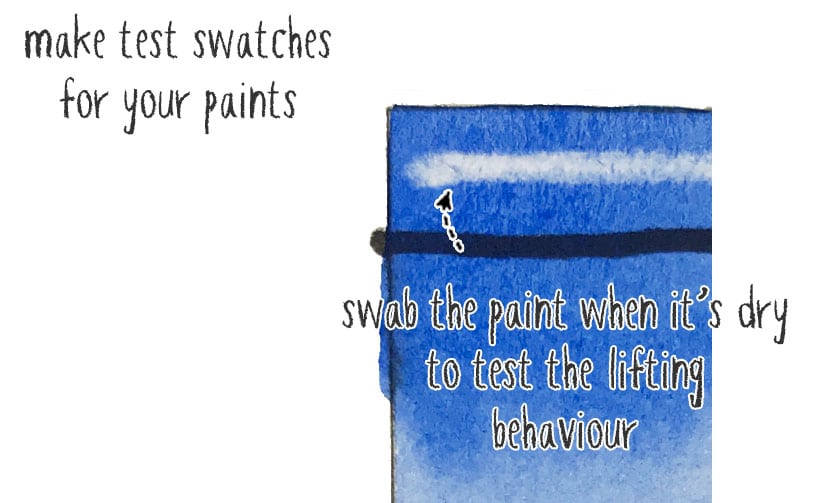
How to choose staining or lifting watercolors
It sounds complicated choosing the staining characteristics of your paints. The problem is, sometimes you want one quality or the other.
Non-staining (liftable) paints are helpful in removing pigments to create highlights.
Staining paints are excellent if you use a glazing technique (layering). This is because the underlying colors will adhere to the paper with each new layer of paint.
I would suggest you need both types of watercolors in your palette. I don’t use this as an indicator for choosing paint.
Suppose lifting is an important consideration in your painting technique. In that case, there is one thing you can try without having to worry about the staining characteristics of your palette!
Lifting mediums – a watercolor additive that aids lifting
A watercolor lifting medium enhances the lifting capabilities of the paper surface. So regardless of the type of paint you’re using, you can still easily lift pigments from the surface.
You just coat the surface of the paper beforehand and leave it to dry. The coating alters the absorbent properties of the paper and makes it simpler to lift off color. Note however that this alters the handling properties of the paper slightly. Paint will dry less quickly and remain fluid on the surface for longer.
However with a lifting preparation like this one you can lift all types of paint including staining watercolors.
Watercolor tools for lifting
Depending on the stage of the painting, there are different tools that artists typically use for removing paint. Here are a few suggestions
- Brushes. A good quality sable brush will absorb moisture well. It is my first choice of tool for lifting during the damp stages of a watercolor painting. A stiff bristle brush is better suited to lifting after the paint has dried.
- Paper towels and sponges. These are great for blotting up more extensive areas of pigment during the wet stage. For example, artists often use these for making cloud shapes. Remember, they have a unique texture that often gets imprinted into the colored wash.
- Knife or scalpel. A sharp instrument like a knife is suitable for scraping. You can correct errors by carefully scratching the surface. A pointed scalpel is excellent for adding bright line details, such as highlights in hair or grass.
- Sandpaper. Using abrasive paper like this produces a subtle effect with soft edges. Only the upper layers of pigment get rubbed off on textured watercolor paper.
If you make a mistake with watercolor, can you erase it?
Yes, watercolor paint can be erased using various lifting techniques.
Watercolor is known for being tricky. Because of the paint’s transparency, you cannot mask the underlying brush marks. But if you make an error, you can remove mistakes to a certain extent.
This has limitations because the more you wear down the surface, the more you damage the paper.
How to erase watercolor
Use a lifting technique such as re-wetting and scrubbing the pigments, then blotting paint from the surface. Abrasive techniques such as scraping with a knife or sandpaper are also effective.
Some people use a special sponge like this, known as a “magic eraser.” (Amazon)
how to stop watercolors from lifting
The best way to prevent watercolors from lifting is to choose paper and paints that resist lifting. Some brands and qualities of paper are better at resisting lifting techniques. For example, staining paints will be harder to remove.
Arches watercolor paper is a strong cotton-based paper and has sizing which reduces lifting, making your brush marks more permanent 🙂

